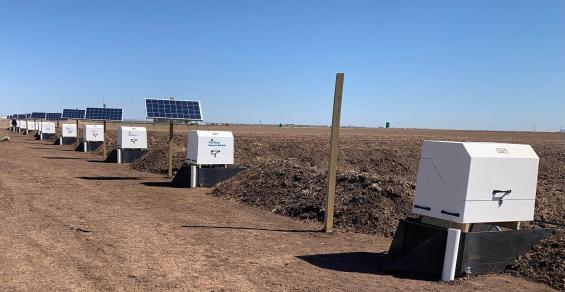The Oklahoma Water Resources Center at Oklahoma State University is teaming up with Texas A&M University for a $1.7 million project to study the benefits of regenerative agriculture in Oklahoma and Texas.
“The water center’s involvement was sparked from discussions on how implementing soil health practices would help achieve Oklahoma’s Water for 2060 goal of consuming no more fresh water in 2060 than was consumed in 2010,” said Kevin Wagner, OWRC director. “There is evidence that practices to improve soil health will also help reach this goal, but there is a need for more research in the Southern Plains.”
Project partners are conducting field research evaluating how the use of cover crops, no-till farming and grazing of cover crops affect soil health, soil carbon, nutrient cycling, greenhouse gases emissions, and water quality and quantity. The field research findings will then be used to develop river basin scale models to evaluate the effects of regenerative agricultural practices at a regional scale. Output from these models will be integrated with economic models to show the potential economic impacts on individual producers and surrounding communities.
Although cover crops have been heavily researched in midwestern states, less research has been done in the drier environment of the Southern Plains, according to Wagner, who said part of the project will be studying using wheat as a cover crop for cotton in the Oklahoma panhandle and southwestern regions. Researchers want to understand how cover crops perform in a semi-arid environment with less rainfall and determine the barriers to adoption.
“The focus of this research is cotton as an essential cash crop for southwestern Oklahoma,” Wagner said. “Although cotton provides certain advantages over corn, such as higher tolerance for salinity and lower need for moisture and irrigation, it also has disadvantages, such as leaving very little cover for the soil after harvest.”
The field research kicked off in the spring of 2022 with the installation of 12 water flumes (water collecting devices) at the Southwest Research and Extension Center near Altus. The flumes collect runoff water samples during rain events to study the effects of soil health practices on nutrients, E. coli, and sediment in the runoff water. In preliminary results, researchers found during the first three runoff events that there was three times higher water runoff amounts from the sites without cover crop versus the sites that had an actively growing cover crop in place.
A new Extension Soil Stewardship Program is also being developed to educate producers on soil management and the research findings from the project.
“Producer concerns are always a top priority in our research. It is part of the land-grant mission to extend our research knowledge to the public to help improve the lives of Oklahomans,” Wagner said. “We envision this research being delivered to agricultural producers to provide them with the information they need to assess how integration of regenerative ag practices may benefit their farm and operation.”
Researchers to study how the use of cover crops, no-till farming, and grazing of cover crops affect soil health.





